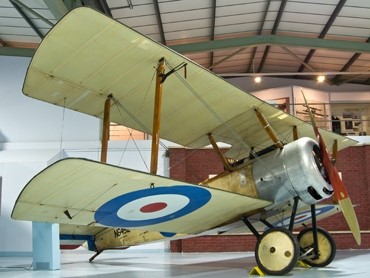-
![LANG-CODE-KEY]() LANG_NAME_KEY
LANG_NAME_KEY

I was recently fortunate enough to be invited to spend the day at the Fleet Air Arm Museum in Somerset (UK), which holds Europe’s largest collection of Naval Aircraft.
The Museum, which opened in 1964, is situated right next to the airfield at RNAS Yeovilton (also known as HMS Heron) and the sound of the aircraft really brings the Museum to life.
Construction of the airfield began in 1939 and the runways were completed in 1941. The Naval Observer School moved to HMS Heron during 1940 and the Naval Air Fighter School soon followed. The runways were extended in 1952 and again in 1957 to cope with jet aircraft.
The Museum comprises four large halls. Each hall has several levels telling the stories of naval aviation from the first manned kites towed behind naval vessels to helium-filled airships, seaplanes, biplanes, carrier-borne aircraft of WWII, modern Sea Harriers and helicopters.

In the early part of the 20th century the British Royal Navy used balloons and airships for reconnaissance. After the failure of the Royal Navy's airship Mayfly in 1911 (she broke in two while being taken out of the hangar), the First Lord of the Admiralty, Winston Churchill, saw a need to develop military aircraft.

In 1912 the government formed the Royal Flying Corps. The British Royal Navy was given the airships owned by the British Army. It was also given twelve aircraft to be used in conjunction with its ships. The first flight from a moving ship took place in May 1912. The following year, the first seaplane carrier, Hermes, was commissioned.

Flight Sub-Lieutenant Warneford RN
When World War I began in August 1914, the newly formed Royal Naval Air Service (RNAS) had 93 aircraft, six airships and just over 700 personnel. When it merged with the Royal Flying Corps to form the Royal Air Force in April 1918, the RNAS had about 3,000 aircraft, over 100 airships and more than 55,000 personnel.
The main role of the RNAS was fleet reconnaissance, patrolling coastlines in search of enemy ships and submarines, attacking enemy coastal territory and defending Britain from enemy air-raids. The leading fighter ace in the RNAS was Raymond Collishaw with 60 victories.

The RNAS was severely criticised for its failure to prevent the Zeppelin bombing raids of southern England in World War I. In February 1916 there was a change of policy and the Royal Flying Corps were given responsibility for dealing with Zeppelins once they were over Britain. The RNAS was now to concentrate on bombing Zeppelins on the ground in Germany.

The RNAS also had fighter squadrons on the Western Front. Popular aircraft with these pilots included the Bristol Scout, the Sopwith Pup and the Sopwith Camel. In April 1918 the RNAS merged with the Royal Flying Corps to form the Royal Air Force. The Royal Navy did not regain practical control of its Fleet Air Arm until 1939.
 Short S27 Replica of the 1910 original |
 Sopwith Pup (replica) |
At the onset of the Second World War, the Fleet Air Arm consisted of 20 Squadrons and 232 aircraft.
World War II brought a change to aviation and naval tactics, moving from ships versus ships conflicts to aircraft versus ships, and the change was made to good effect. The crippling of the Italian Fleet in Taranto Harbour by Swordfish biplanes carrying torpedoes in a night attack in 1940 was undoubtedly the most notable Fleet Air Arm success of the war.
The FAA served in almost every theatre of the Second World War, taking part in the Battle of France, Battle of Britain, Battle of the Atlantic, North Africa and Libyan Desert campaigns, D-Day landings at Normandy, battles in the Pacific and Indian oceans, and the invasions of Madagascar, Japan, Sicily, Italy, and Southern France.
 Corsair KD 431 |
 Fairey Firefly TT4 |
The FAA was also responsible for sinking the largest amount of enemy shipping of any British military branch and was one of the main weapons used against German U-Boats. FAA aircrew were adept at aerial combat, their ranks included many air aces and earned numerous honours including two Victoria Crosses as well as many Distinguished Service Orders (DSO), Distinguished Service Crosses, Distinguished Service Medals (DSM) and Mentions in Despatches.
 F4U Corsair |
 Supermarine Seafire F17 |
By the end of World War II the strength of the Fleet Air Arm was 59 aircraft carriers, 3,700 aircraft, 72,000 men and 56 air stations located all over the world. The aircraft carrier had replaced the battleship as the Fleet's principal ship and its aircraft were strike weapons in their own right.
The FAA’s piston-engined aircraft were reaching the limits of their development. The Hoverfly, the first operational helicopter, had already been introduced to the Fleet Air Arm and the Sea Fury, together with the Firefly, bore the brunt of the next conflict - the Korean War.
Supermarine Seafires, Hawker Sea Furies and Fairey Fireflies from a succession of light fleet carriers provided the only British air contribution to the Korean War. The Westland Dragonfly, one of the first Search and Rescue helicopters, was first used in this war.
 LIM2 (MIG 15 copy) |
 Sea Harrier |
 McDonnell Douglas F-4 Panthom II McDonnell Douglas F-4 Panthom II |
The Museum is first class, a fascinating insight into the history of the FAA and a must see for anyone with an interest in aviation. They are currently working on some fascinating projects including the restoration of a Fairey Barracuda (more about this later).

My huge thanks to all at the Museum for their kindness and the opportunity to visit them.